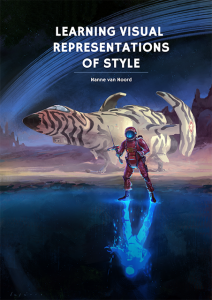On May 16, 2018 Nanne van Noord defended his PhD thesis on learning visual representations of style at the University of Tilburg. He conducted his PhD research as part of the REVIGO project, prior to joining the SEMIA team. Below, he provides a short summary of his PhD thesis; a digital version of the thesis can be found here. The insights he gained carrying out this research feed into the feature extraction and analysis portion of the SEMIA project.
An artist’s style is reflected in their artworks. This style is independent from the content of the artwork, two artworks depicting two vastly different scenes (e.g., a beach scene and a forest scene) both reflect the artist’s style. By recognising the style of the artist, experts, and sometimes even laymen, can tell the same artist created both artworks. Replicating this ability for connoisseurship in a computer, and potentially even giving a computer the ability to produce artworks in the style of the artist, is the main goal of the work I did for my thesis.
To analyse artworks with a computer we can use techniques from the field of computer vision. Traditionally, these techniques rely on handcrafted features to describe the characteristics of an image. However, in recent years the field of computer vision has been revolutionalised by the emergence of deep learning models. These are models which learn from the data a feature representation optimised for a task.
Deep learning models have been shown to be enormously successful on a wide range of computer vision tasks. Therefore, in my thesis I explore the application of deep learning models for learning representations of the artist’s style. By learning the representation we might discover new visual characteristics of artists, enriching our understanding of the artist’s style. Moreover, such a representation might enable new and novel applications.

